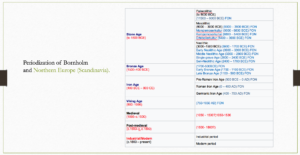The prehistory of the Scandinavian region is very rich and it can take us back 14,000 years ago when it was inhabited by prehistoric societies in the time we call now the end of the last Ice Age. 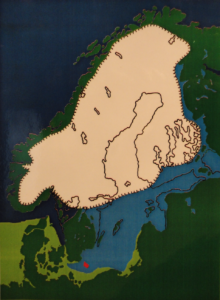 We know that during the ice age, almost all of Scandinavia was covered by glaciers, except for the southwestern parts of what we now know as Denmark. As the ice began to withdraw the landscape transformed into tundra that became soon occupied by big mammals, such as the reindeer (Rangifer tarandus) and the elk (Alces alces) and it is to assume that early hunters followed them to new lands to hunt them. During those times, not only the climate conditions were different, the geography of Northern Europe was also different from nowadays. The sea levels were much lower and mainland Europe was connected by a land called ‘Doggerland’ with the island of Great Britain, which at the same time was connected to the Jutlandic peninsula – now under the North Sea. What is now Denmark and Sweden were also connected and created a huge lake of freshwater, covering approximately the area of the present Baltic Sea. Bornholm was at this period the farthest point of a peninsula that connected the norther part of the nowadays Germany.
We know that during the ice age, almost all of Scandinavia was covered by glaciers, except for the southwestern parts of what we now know as Denmark. As the ice began to withdraw the landscape transformed into tundra that became soon occupied by big mammals, such as the reindeer (Rangifer tarandus) and the elk (Alces alces) and it is to assume that early hunters followed them to new lands to hunt them. During those times, not only the climate conditions were different, the geography of Northern Europe was also different from nowadays. The sea levels were much lower and mainland Europe was connected by a land called ‘Doggerland’ with the island of Great Britain, which at the same time was connected to the Jutlandic peninsula – now under the North Sea. What is now Denmark and Sweden were also connected and created a huge lake of freshwater, covering approximately the area of the present Baltic Sea. Bornholm was at this period the farthest point of a peninsula that connected the norther part of the nowadays Germany.
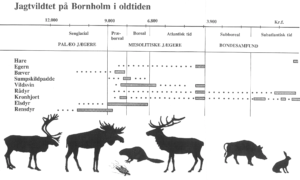 As the temperatures increased, powerful rivers of melted ice started to flow and shape the new lands, and a more vegetation and fauna gradually began to arrive, changing the landscape of the Scandinavia region and Denmark.
As the temperatures increased, powerful rivers of melted ice started to flow and shape the new lands, and a more vegetation and fauna gradually began to arrive, changing the landscape of the Scandinavia region and Denmark.
It took some other thousand years (around 3,000 B.C.E.) for the geography of Denmark to make another change and it was transformed approximately in what it looks today. A big part of this change was due to the increase in temperature that affected a large-scale melting of the northerly glaciers creating a rapid rise of the sea level which resulted in Bornholm becoming an island detach from Germany and Denmark turning into a country of fjords, rivers and islands. (Links)
Paleolithic and Mesolithic Bornholm (12000 – 3900 BCE)
The earliest records of human activity on Bornholm is limited to the finds of a flint arrow-head and a harpoon in the Vallensgård bog in the middle of the island, probably left behind by seasonal hunters that followed the game across the peninsula during the summer hunts. The first real inhabitants of 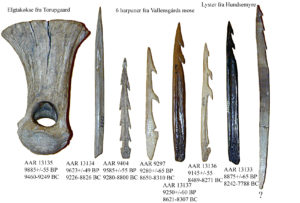 Bornholm arrived around 8600 B.C.E. They were hunter-gatherer societies, who would have exploited seasonal fruits, nuts and berries as well as stalked large game and fished the surrounding sea and inland waterways. Some of the earliest finds from this period are axe made of elk’s antler and harpoons for fishing made of elk’s bone and antlers , but in general the material culture from the Mesolithic is characterized by small flint blades known as microliths. They were too small to have been used on their own and formed part of composite tools such as knives and arrows. These microliths were fragments from small flint nodules which were the only local source of flint.
Bornholm arrived around 8600 B.C.E. They were hunter-gatherer societies, who would have exploited seasonal fruits, nuts and berries as well as stalked large game and fished the surrounding sea and inland waterways. Some of the earliest finds from this period are axe made of elk’s antler and harpoons for fishing made of elk’s bone and antlers , but in general the material culture from the Mesolithic is characterized by small flint blades known as microliths. They were too small to have been used on their own and formed part of composite tools such as knives and arrows. These microliths were fragments from small flint nodules which were the only local source of flint.
It seems that societies lived in single family settlements inland during the summer period, and then, gathered in bigger camps closer to the sea in wintertime. In fact, most of the Mesolithic sites so far uncovered have been located close to water resources. This was probably because riverine and coastal locations gave access to the widest range of wild foods, and also because in such a wooded island, the sea would have allowed the quickest and easiest means of transport via dug-out canoes to the main land. Some of the surviving Mesolithic sites such as Ålyst was an inland settlement, and Kobbebro was of the few coast settlements, but most of the sea side settlements are now under water due to the rise in sea level in the period from 6800 – 3000 BCE (the Kongemose, Ertebølle and the early Neolithic), so most of the coast settlements of these periods must be submerged.
During the late Ertebølle culture the coast settlements re-appeared at 4500-3900 BCE and are located along the coastline that was 5 meters higher than it is today. At the same time, there was a shift in cultural orientation which means that the people were connected to what is now the Swedish coast, opposite to the early Mesolithic period when the inhabitants were orientated towards mainland Europe. The finds are dominated by arrowheads but it’s also from this period that we see the first ceramic.
The site Grisby have provided very rich finds of organic material, the vast amount of bones from fish and seal have provided an insight into the diet and daily life of that period.
Neolithic Bornholm (3900 – 1700BCE)
The next phase in the prehistory of Bornholm saw the arrival of the first farmers in and around 3900 B.C. Even though there had been a thriving farming community for a thousand years only 150 km away in northern Germany, the agricultural technology and way of life came from the southeastern part of Sweden with the Funnel Beaker culture. They brought with 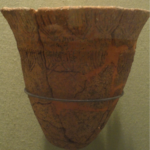 them new ideas about food production and had the knowledge to grow crops and raise domesticated animals such as cows, sheep, pig and goats. The contact must have been strong to provide Bornholm with the big amount of flint axes and tools that are found today. These were all transported from Sweden to Bornholm in dug –out canoes while there are no natural flint resources on the island. The axes were a necessity in the process of deforestation by the slash and burn technique that slowly transformed the forest of the island into farmlands.
them new ideas about food production and had the knowledge to grow crops and raise domesticated animals such as cows, sheep, pig and goats. The contact must have been strong to provide Bornholm with the big amount of flint axes and tools that are found today. These were all transported from Sweden to Bornholm in dug –out canoes while there are no natural flint resources on the island. The axes were a necessity in the process of deforestation by the slash and burn technique that slowly transformed the forest of the island into farmlands.
The first farmers also introduced some of the earliest pottery vessels as well as utilizing a much wider set of artefacts, including polished stone axes, a variety of flint tools and saddle querns for grinding grains. They lived in large rectangular houses up to 44 meters long made of wooden beams with hazel wicker and daub in between, and most likely thatched roofs. These houses have been identified throughout the island, with notable examples including Limensgård, Brogård and Ndr. Grødbygård. Their inhabitants appear to have practiced a mixed farming lifestyle growing crops such as emmer wheat (triticum dicoccum) and herding cows and sheep, while wild foods would also have been exploited.
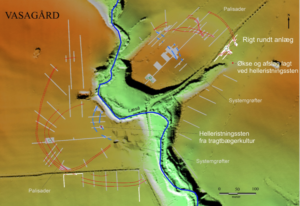 From 3500 BCE, and forward the settlements became more place bounded and were foremost located on the south-eastern part of the island 1-2 kilometer inland on fertile soils. Near these big settlements, two enormous gateway enclosures (Vasagård and Rispebjerg) were constructed. The occupation of these area peaked in two periods, the first period comprises the constructions of ditches that were used from 3500-3300 BCE, most likely for rituals, feasts and burials that were exhumed to be later reburied in nearby long barrows. In the second period from 2900-2800 BCE elongated palisades of up to 1,5 km were constructed in up to six rows at the time to surround the area.
From 3500 BCE, and forward the settlements became more place bounded and were foremost located on the south-eastern part of the island 1-2 kilometer inland on fertile soils. Near these big settlements, two enormous gateway enclosures (Vasagård and Rispebjerg) were constructed. The occupation of these area peaked in two periods, the first period comprises the constructions of ditches that were used from 3500-3300 BCE, most likely for rituals, feasts and burials that were exhumed to be later reburied in nearby long barrows. In the second period from 2900-2800 BCE elongated palisades of up to 1,5 km were constructed in up to six rows at the time to surround the area.  In these extensive gateway enclosure, there is evidence of at least 40 timber circles with a diameter up to ten meters, probably used as temples or altars. Recent excavations have recovered burned grains, flint axes and bones deposited in their postholes as part of rituals. From these sites there have been found also more than 300 small ornamented stones called sunstones with stylized engravings of the sun, spider webs and field crops.
In these extensive gateway enclosure, there is evidence of at least 40 timber circles with a diameter up to ten meters, probably used as temples or altars. Recent excavations have recovered burned grains, flint axes and bones deposited in their postholes as part of rituals. From these sites there have been found also more than 300 small ornamented stones called sunstones with stylized engravings of the sun, spider webs and field crops.
It’s also from Vasagård that we have recently found the oldest examples of rock carvings in Scandinavia starting the tradition nearly a thousand earlier than formerly assumed.
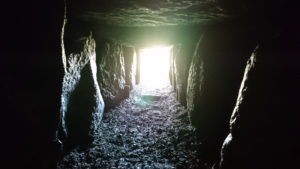 One of the most distinctive aspects of the Neolithic was the introduction of new and monumental forms of burial architecture in the guise of megalithic tombs. These included a variety of monument types with the four most notable being court tombs, portal tombs, passage tombs and wedge tombs.
One of the most distinctive aspects of the Neolithic was the introduction of new and monumental forms of burial architecture in the guise of megalithic tombs. These included a variety of monument types with the four most notable being court tombs, portal tombs, passage tombs and wedge tombs.
Bronze Age Bornholm (1700 – 500BCE)
The next major phase in Bornholm’s prehistory is characterized by the arrival of metalworking. Initially these new metal objects were fashioned out of copper and mainly consisted of knives and especially axes (like the battle-axe from Elleby). They occurred in small quantity during the later part of the Neolithic period and due to the influence from central Europe the material culture slowly changed from mainly consisting of stone tool and weapons to bronze. However, bronze objects weren’t accessible for most the society and flint was used throughout the bronze age, objects like sickles, axes and arrowheads. 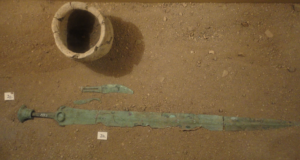 There was a wide range of items made of stone that imitated bronze objects mainly bronze axes and daggers. A broad variety of objects were made of this new material including axes, swords, spears, knives, combs, spindle-whorls and jewelry. In addition, the Bronze Age also saw a growth in fine gold working with some beautiful objects. These items were of high status and in some cases linked to the religious sphere and suggest the presence of new social elites both controlling the richness and the religious activities of the society.
There was a wide range of items made of stone that imitated bronze objects mainly bronze axes and daggers. A broad variety of objects were made of this new material including axes, swords, spears, knives, combs, spindle-whorls and jewelry. In addition, the Bronze Age also saw a growth in fine gold working with some beautiful objects. These items were of high status and in some cases linked to the religious sphere and suggest the presence of new social elites both controlling the richness and the religious activities of the society.
During the early bronze age, big grave mounds were constructed for individuals from the higher stratus of society who were inhumed and placed with rich grave goods that reflected their place in society. The chests where made of oak trunks, planks or where lined with stones and in several of them there have been later burials so many of the mounds contains many burials from a vast amount of time from late bronze age to early iron age. The mounds were made of stones and frequently cover with soil. The mounds of which 200 still exists were often placed on notable ridges in the landscape close to the coast and streams.
In later part of the Bronze Age cremation became the dominant ritual. After 1.100 BCE the dead were cremated and grave goods became less common. The cremations could occur in pits or sometimes within small circular barrows, and regularly the big mounds from the early bronze age were used for new smaller burials that were dug in one side of the mound.
There are at least 400 cairns and 250 standing stones that are dated to the later part of the bronze age between 1100-500 BCE. Most of the cairns are between 2-10 meters in diameter and up to 2 meters high, but there are also 15 cairns in the shapes of ships rating from 7 to 30 meters in length. A well-known location is Egeby with its 82 round and 8 ship formed cairns.
There is not much evidence of settlements, especially from the early bronze age, but it seems like some of the burials and mounds where located in the periphery of the settlements and can be considered for future excavation campaigns. Information recovered, indicates an increase in population and the pollen records suggests that extensive forest clearance took place during this period to open new farmland areas, with large field systems being laid out at sites such as Blemmelyng.
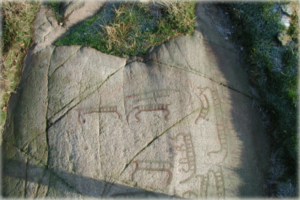 It is also this period the one that comprises most of the 220 rock carving locations. It has been considered that some sort of religious activity took place in sites. Examples of these places are Madsebakke and Hammersholm where fine pictures of ships and wheel crosses (hjulkors) along with cup marks and figures of feet were carved into the rock, probably to worship the sun. The ship and the animals (horse, snake, fish) helping the sun through the day and the night realm can be seen on several bronzes razors from Bornholm.
It is also this period the one that comprises most of the 220 rock carving locations. It has been considered that some sort of religious activity took place in sites. Examples of these places are Madsebakke and Hammersholm where fine pictures of ships and wheel crosses (hjulkors) along with cup marks and figures of feet were carved into the rock, probably to worship the sun. The ship and the animals (horse, snake, fish) helping the sun through the day and the night realm can be seen on several bronzes razors from Bornholm.
During this period societies organized around warrior aristocracies, but should rather be seen representing a decentralized form of chiefdom/stratified society, based on free landholding farmers, who formed an elite stratum controlling commoners and slaves through warrior might. Pottery continued to be used during this period for both domestic and ritual activity, as were flint tools such as arrowheads, knives and scrapers.
The Iron Age on Bornholm is the riches period in terms of archaeological finds with more than 300 graveyards, 130 settlements along with iron production and sacrificial sites and four hilltop enclosures. (Explain the subdivision of these period)
In Sweden, the Late Germanic Iron Age (400–750AD) is usually called the Vendel era, in Norway, the Merovinger (Merovingian) Age. (Links)
Pre-Roman Iron Age (500BC – 0 AD)
As the name of the period suggests this era was characterized by iron tools and weapons, but it was not an abrupt change and a slow development, as a matter of fact, random objects of iron appeared in bronze age graves and bronze continued to be used to make items of jewelry all through the iron age. Perhaps because the old long range trading networks, south-north between the Mediterranean cultures and Northern Europe, had broken down at the end of the Nordic Bronze Age and caused a rapid and deep cultural change in Scandinavia. Bronze, which was an imported metal, suddenly became very scarce and iron, which was a local natural resource, slowly became more abundant, as the techniques for extracting, smelting and smiting were acquired through contact with groups from nowadays Germany and Poland. Iron was extracted from bog iron in peat bogs and the first iron objects to be fabricated were needles and edged tools such as knives and sickles. The increase of iron use in Scandinavia was slow, bog ore was only abundant in southwestern Jutland and it was not until 200–100 B.C., that the iron-working techniques were generally mastered and a productive smiting industry had evolved in the larger settlements, also in Bornholm. This first part of the Iron age, the pre-roman Iron age, is very rare in archaeological finds, this is mostly due to the continuation of the cremation tradition as the pre-dominant burial rite from the later bronze age until at least the earliest roman iron age around AD. In some cases, the burning of the corpses included small personal items such as beads or jewelry that were burned along with the body before the ashes and bones were deposit in a small pit that were occasionally marked by a stone. It is common to find these graves in big clusters or cemeteries of up to 1500 graves.
The settlements were located between 500-1500m from the coast and are often found closely connected to the cemeteries. They are mainly found on the rich clay soils close to nowadays Østerlars, Ibsker, Aaker and Klemmensker, areas that up to the present have been the main producers of agricultural products.
Roman Iron Age (1 – 400 A.D.)
The term -The Roman Iron Age (1–400 AD), comes from the hold that the Roman Empire had begun to exert on the Germanic tribes of Northern Europe. In Scandinavia and Bornholm, there was a great import of goods, such as coins (more than 7,000 up to now), vessels, bronze images, glass beakers, enameled buckles, weapons, etc. Furthermore, the style of metal objects and clay vessels was unmistakably Roman.
Great ships made for rowing have been found from the 4th century in Nydam Mose in southern Denmark and they reflect the contact to the continent in form of trade and warfare, possible to detect due to the big number of archaeological finds from the beginning of the period. Most of the items and gods of roman origin that have been found in Denmark and on Bornholm came from the northern provinces of the empire and were likely traded by the northern Germanic tribes, but there is also a possibility that a few warriors that have served in the roman army had returned with some of the sparthas and roman military orders that are found from the period. The military organization is reflected in the cemeteries from the roman iron age, where a large number foot soldiers and mounted warriors can be found, as well as four of the five remaining hill forts dated to this period.
There is a shift in burial practice from the predominant cremation type to the inhumation that can also be observed in Bornholm, Slusegård, Simblegård og Enekrogen. Along with the shift in burial practice there is an increase in rich warrior graves that started in the latest part of pre-roman iron age and continued through roman and Germanic iron age and only ended in the beginning of the Viking era. The division between rich and poor graves and those with weapons or without points at a division in society that can also be seen in the concentration of wealth (imported items) in the biggest settlements. At the end of the roman iron age the amount of gold and silver roman coins arriving to Bornholm increased significantly and the total amount of these coins are higher than the rest of western Denmark all together. For this reason, it has been considered that the island’s wealth and its central role in the Baltic trade network is founded in the first centuries AD and continuous blossom in the following Germanic iron age. (Links)
Germanic Iron Age (400 – 750AD)
The Germanic Iron Age is divided into two periods: the early Germanic Iron Age and the Late Germanic Iron Age.
As the Roman Empire was in decline an abundance of gold flowed into Scandinavia and some excellent examples of these gold artifacts from this period have been found.
Most of the richness found in Bornholm for this period derives from settlements across the island but especially from Sorte Muld, the biggest central settlement in the island. Sorte Muld covers more than 1 square km, and cultural layers of up to 1,5-meter-deep, something which points at the highly active settlement. The abundant finds of gold, semi-precious stone from India, roman glass and weapons underlines its importance as a center of trade, military and belief in Scandinavia from about 500-700 AD. It has been considered that a good part of the success Sorte Muld as a trade center is due to its position in the Baltic sea and the many natural harbors on the coastline with a road, that is still visible today, leading from the coast to this site. Besides its functioning as a trade center, the discovery of more than 3000 gold-foil figures “Guldgubber”, weapons and gold ritually deposited, something that allows to consider this site as a religious center where probably the elite conducted religious practices for the society. It is still not known where the cemetery associated to Sorte Muld is located, the only location with sufficient rich graves is situated 15 km up the coast and is dated to the end of the settlements peak from 650 AD to the beginning of the Viking age and cannot be directly connected to the settlement. The cemetery, Nørre Sandegård Vest, is the biggest and wealthiest cemetery from the 6th-8th centuries in Denmark, with very well defined and highly militarized family groups and rich females’ graves.
At the end of the 7th centuries the central settlements split up into single farmsteads, but lots of the religious figures and tales from the Late Germanic Iron Age in the 8th century blended into the Viking Age and the proto-historical period, with legendary or semi-legendary oral tradition recorded a few centuries later in the Gesta Danorum, heroic legend and sagas, and an incipient tradition of primary written documents in the form of rune stones. (Links)
Viking Age Bornholm (750AD -1050AD)
Vikings were societies organized around warrior aristocracies representing a decentralized form of chiefdom or stratified society, based on free landholding farmers, who formed an elite stratum controlling commoners and slaves through warrior might. Common to the Viking Age was the securing of long-distance trade and political stability, as well as the potentially disruptive forces that may destroy such political networks. This kind of decentralized political economy would need political confederacies that allowed the control of larger segments of trade routes. A Chiefdom confederacy is formed by a number of genealogically related and unrelated chiefdoms, which were unified through coercion or common agreement. Bornholm appears in the written sources for the first time as a traveler in approximate 890AD, going from Hedeby in Jutland to Truso in Poland, he wrote that Bornholm had its own king. The second-time that written sources refer to Bornholm is in Adam of Bremen’s description of Scandinavia in 1070 where Bornholm (Holmus) is described as a part of the Danish kingdom.
The Viking Age was still based on a decentralized political economy, which has only started the move towards a more centralized political economy, based on towns as administrative centers. This implies that the similarities reside in the social structure, which therefore produces a similar set of material representations. Some elements, like the use of barrows, were obviously part of an old ritual tradition, visible in the landscape, and the same is true of ship settings. On Bornholm, there are no signs of towns, barrows and rich graves are scarce as well; but the island’s role as an important location in the trade routes can be identified in the amount of silver treasures found on the island. There is approximately one Viking silver treasure found every year, and the around 130 treasures from the island makes up nearly half of the Danish Viking age silver treasures.
The riches and success of the Vikings were mainly due to new maritime and shipbuilding technologies that allowed the expansion of trade networks, as well as the formation of a semi- independent maritime economy and the contacts to the rest of Scandinavia, England and in the case of Bornholm especially the Baltic coast. It is important to consider that a big amount of the silver found in Bornholm came from the Middle East and it was most likely obtained by Vikings from Bornholm who traded with merchants of the island and the Baltic coast or along the rivers of nowadays Russia.
Vikings were also farmers and there are a lot of archaeological finds of Viking age settlements and houses in Bornholm. Archaeological remains of these settlements have been found all over the island for example nearby Runegård in Aaker, and as a matter of fact, some of the farmsteads in Bornholm today are still in the same locations as those settled during the Viking period. This recurrent settlement over previous constructions has created an overlapping, which documents the entire history of the settlements in the island and its transformation.(Links)
